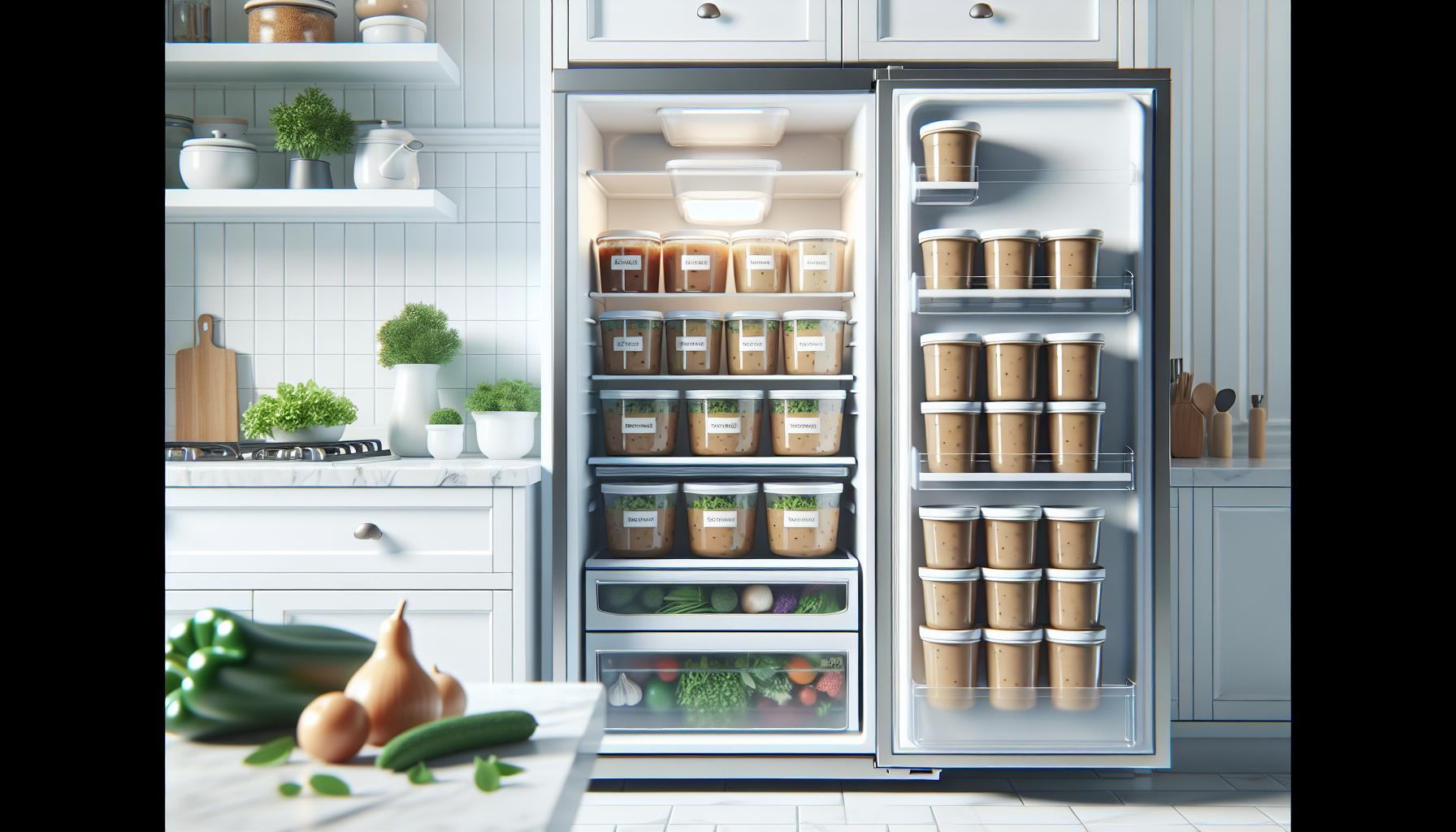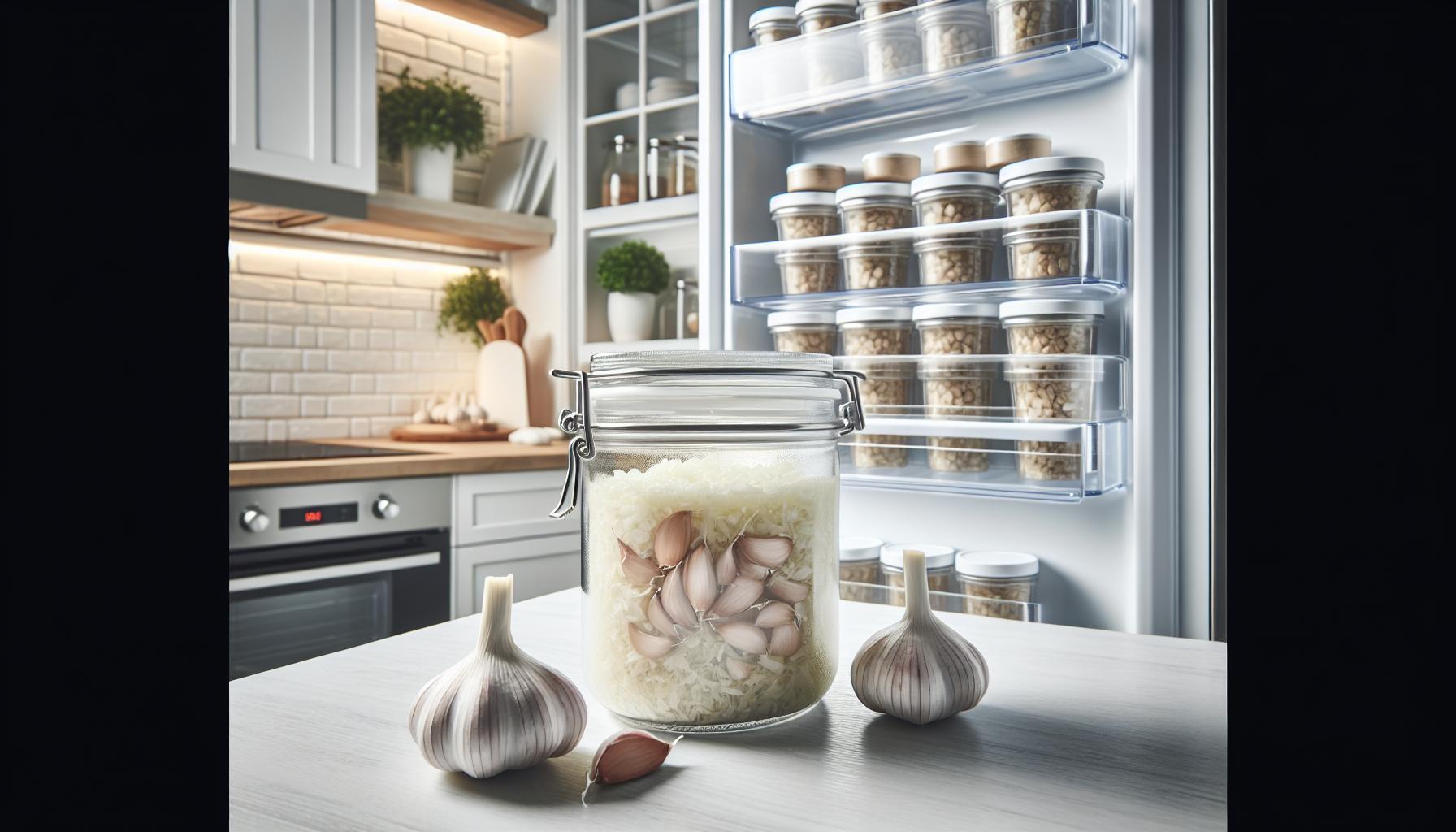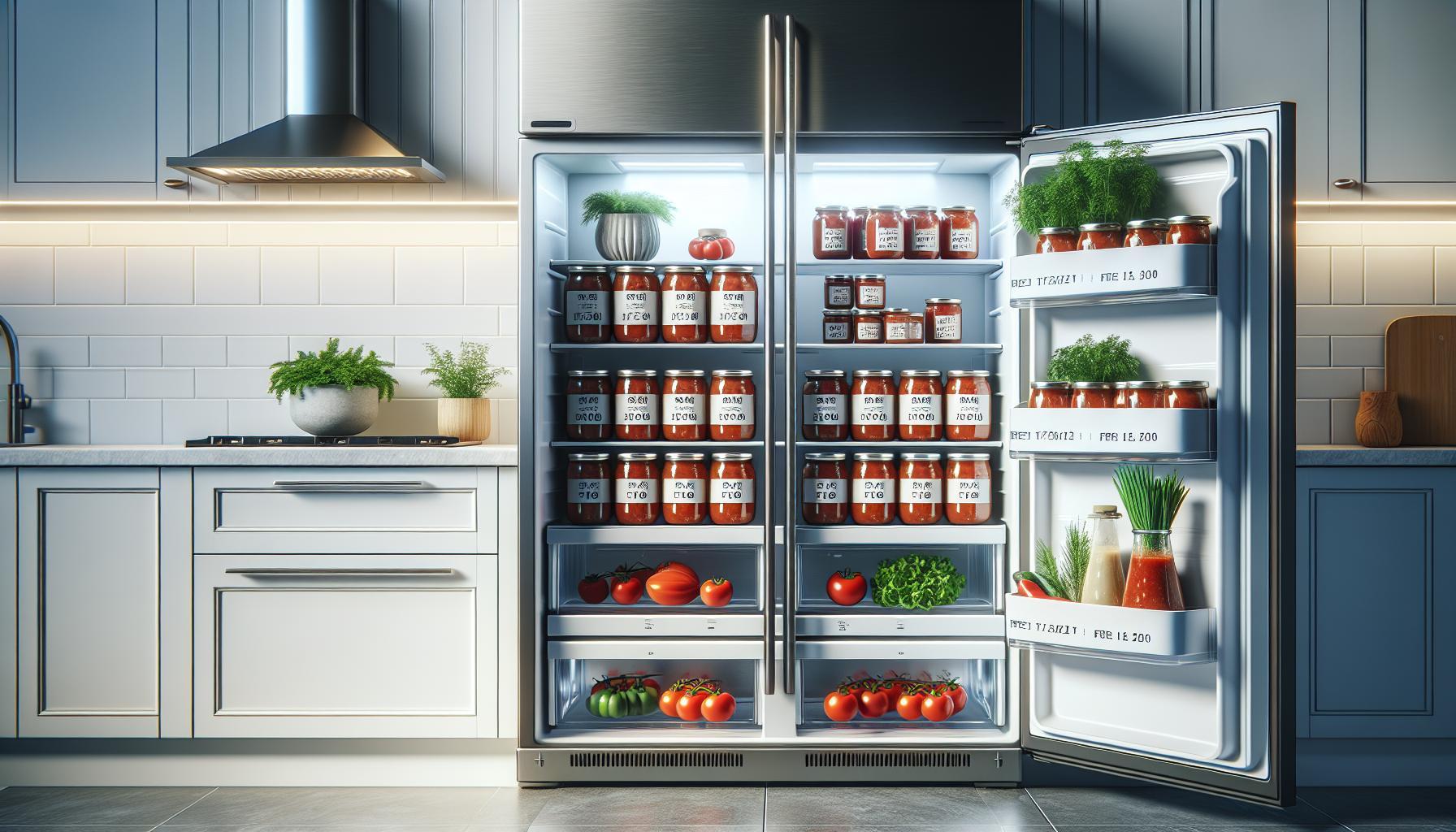When it comes to enjoying delicious meals, gravy often serves as the crowning touch. But how long can you safely store this savory addition in the fridge? Understanding the lifespan of gravy not only helps you reduce waste but also ensures that every drop you savor is safe to eat.
Many home cooks find themselves with leftover gravy after family dinners, leading to the common dilemma of whether it’s still good days later. Knowing the proper storage techniques and timelines is crucial to maintaining the rich flavors and preventing spoilage. This guide will provide you with essential storage guidelines and practical advice to keep your gravy fresh for as long as possible, allowing you to reap the benefits of your culinary creations without compromise. So, let’s dive into how long gravy lasts in the fridge and how to maximize its shelf life, ensuring you never waste a drop of that savory goodness.
How Long Can You Store Gravy in the Fridge?
Gravy is a delicious accompaniment to many meals, but it’s essential to know how long it can safely be stored in your fridge to prevent foodborne illness. Generally, homemade or store-bought gravy can last in the refrigerator for about 3 to 4 days. It’s crucial to store it in an airtight container to minimize the risk of contamination and maintain its flavor and texture. If the gravy is made from meat, it is particularly important to adhere to these timeframes due to the presence of protein, which can spoil more quickly.
To extend the life of your gravy, always allow it to cool to room temperature before refrigerating. Hot gravy can raise the temperature inside your fridge, potentially affecting other stored foods. When you are ready to use the leftovers, remember to check for off smells or unusual textures, which are indicators that it might be time to discard it. Keeping track of the storage date on your containers can also aid in ensuring you consume it within the recommended time frame.
For those who want to keep gravy for a more extended period, consider freezing it. Gravy can typically be frozen for up to four to six months without losing significant flavor or quality. When storing gravy in the freezer, use freezer-safe containers or bags, leaving some space for expansion as the liquid freezes. This practice allows you to enjoy your favorite gravy later without the worry of spoilage.
Signs Your Gravy Has Gone Bad
Gravy can elevate a meal, but it’s essential to recognize when it has gone bad to avoid any health risks. One of the most obvious signs is a noticeable change in smell; if your gravy has developed an off or sour aroma, it’s a strong indicator that bacteria have begun to multiply. Similarly, a change in texture-such as separation or unusual thickness-can signal spoilage. Fresh gravy should have a smooth consistency; if it appears curdled or has an oily sheen, it’s best to discard it.
Another critical sign to watch for is mold growth. If you see any mold, whether on the surface or throughout, this is a sure sign that the gravy has spoiled and should not be consumed. Additionally, if your gravy has been in the fridge for longer than the recommended 3 to 4 days, it’s not worth the risk, even if it seems fine. Always trust your senses: when in doubt, throw it out to ensure your safety and health.
Using a simple technique, you can also conduct a taste test-if it tastes off or has an unusual flavor, it’s time to discard it. Always prioritize safety, as spoiled gravy can lead to foodborne illnesses. Recognizing these signs will help you enjoy your gravy at its best while keeping your meals safe and tasty.
Best Practices for Storing Gravy Safely
Properly storing gravy is crucial for maintaining its quality and ensuring it’s safe to consume. Gravy, like many cooked foods, can become a breeding ground for bacteria if not handled correctly. When storing gravy in the fridge, always allow it to cool to room temperature before transferring it to a storage container. This prevents raising the overall temperature of the fridge, which can compromise the safety of other foods.
Use airtight containers made from glass or food-grade plastic to protect your gravy from contaminants and limit exposure to air, which can lead to bacterial growth. Ensure that the container is sealed tightly to maintain the gravy’s flavor and consistency. It’s recommended to store gravy on a shelf in the refrigerator rather than in the door, as the temperature fluctuates more frequently in the door compartments.
Gravy typically lasts in the fridge for about 3 to 4 days. Label your containers with the date of storage, so you can keep track of how long it’s been. If you have a larger batch that you won’t use within that timeframe, consider freezing portions in smaller containers or ice cube trays. This allows for easy reheating later without needing to thaw large amounts at once. Always remember, when in doubt, throw it out-safety should always come first!
Extending Gravy’s Shelf Life: Tips and Tricks
To prolong the shelf life of your gravy and ensure every delicious drop is enjoyed, implement several practical strategies. Gravy benefits immensely from proper storage and handling, and a few simple steps can keep it safe and flavorful for a longer duration.
One effective method for extending the life of your gravy is to immediately cool it down after cooking. This can be achieved by transferring it to a shallow container, which allows the heat to dissipate more quickly. Avoid leaving gravy at room temperature for longer than two hours, as this can increase the risk of bacterial growth. Once cool, store the gravy in airtight containers to prevent air exposure, which can alter its consistency and flavor over time.
Additionally, consider portioning your gravy before storage. Use smaller containers or even ice cube trays to freeze individual servings. This not only protects the quality of the gravy but also makes it easy to reheat only what you need without thawing a large batch. Label your containers with the date to keep track of freshness. As a rule of thumb, gravy can be stored in the fridge for 3 to 4 days, while frozen gravy is best used within 4 to 6 months.
Finally, when reheating gravy, do it gently on the stove rather than in the microwave to avoid uneven heating, which can compromise flavor and texture. Stir frequently and add a splash of stock or water if it appears too thick. By following these tips, you can savor your gravy for every meal without worry.
Freezing Gravy: What You Need to Know
To avoid wasting your delicious gravy, freezing it is a fantastic option that ensures you can enjoy that rich flavor later without any loss in quality. Gravy freezes remarkably well, given that proper techniques are followed, allowing you to keep it for 4 to 6 months without major flavor degradation. The process is straightforward and will save you time on future meals.
To freeze gravy effectively:
- Cool It Down: Before freezing, allow the gravy to cool completely. This can be accomplished by placing it in a shallow container, which accelerates the cooling process.
- Portioning: Consider freezing gravy in smaller portions. Use ice cube trays or small freezer-safe containers to store just what you need, making it easy to thaw the perfect amount later.
- Labeling: Don’t forget to label your containers with the date of freezing. This will help you keep track of its shelf life and ensure you use it while it’s still at its best.
When you’re ready to use your frozen gravy, the best practice is to thaw it in the refrigerator overnight. For quicker thawing, you can also place the container in a bowl of cold water. Once thawed, reheat it on the stove over low heat, stirring often to maintain a smooth consistency. If the gravy appears too thick, a splash of broth or water can help restore its silky texture. Following these simple steps will enable you to enjoy your gravy well beyond its initial cooking date, ensuring no savory drop goes to waste.
Reheating Gravy Without Losing Flavor
To maintain the rich flavor of your gravy while reheating, it’s essential to use gentle, controlled heat. This preserves its texture and ensures that the delicate flavors, developed during cooking, remain intact. When reheating gravy, whether it’s from the fridge or frozen, a few simple techniques can make a significant difference.
Start by allowing the gravy to come to room temperature, especially if it has been stored in the fridge. This helps reduce the reheating time and minimizes the chances of uneven heating, which can lead to hot spots and the risk of burning. Transfer the gravy into a saucepan, and set your stove to a low heat setting. Stirring frequently as it warms up is crucial-this helps distribute the heat evenly and prevents sticking at the bottom of the pan.
If you find the gravy is too thick after reheating, simply add a splash of broth or water to attain your desired consistency. This not only helps restore creaminess but can also enhance the flavor profile. For an extra boost, consider adding a touch of fresh herbs, garlic, or a pinch of seasoning while reheating to invigorate the flavors that may have dulled during storage.
Avoid using a microwave for reheating gravy if possible, as the rapid heating can create uneven temperatures and dry spots. However, if you choose this method, do so in short intervals-about 30 seconds at a time-stirring in between each interval to help achieve an even and smooth consistency. This careful reheating approach ensures that your gravy remains as delicious as when it was first made, ready to complement your favorite dishes without compromising on taste.
Using Leftover Gravy: Creative Recipe Ideas
Using leftover gravy can transform your meals into something exceptional without letting anything go to waste. Gravy is incredibly versatile, and repurposing it can save time and add depth to your dishes. Whether you have a creamy mushroom gravy or a rich turkey gravy, there are countless ways to incorporate it into your cooking repertoire.
One of the simplest ways to use leftover gravy is to enhance your breakfast. Pour it over scrambled eggs or mix it into your morning hash for added flavor. You can also use it to create a savory breakfast casserole by combining it with leftover vegetables and bread, baking until golden and bubbly. For lunch or dinner, consider using gravy as a foundation for a delicious shepherd’s pie or a pot pie. Layer your favorite proteins and vegetables in a baking dish, pour the gravy over, and top with mashed potatoes or pie crust for an easy and satisfying meal.
Additionally, gravy can be a wonderful ingredient in soups and stews. Just add a few spoonfuls to your broth as a flavor booster. This will not only enhance the taste but also thicken the consistency, making your dish heartier. If you’re feeling adventurous, stir leftover gravy into pasta sauces for an unexpected flavor twist, or use it as a dipping sauce for meatballs or chicken tenders.
Finally, consider using gravy in creative sauces for sandwiches or burgers. A drizzle over a roast beef sandwich can elevate it to new heights, delivering that robust flavor every bite craves. With these innovative ideas, you can ensure no drop of gravy is wasted while keeping meals exciting and flavorful!
Understanding Food Safety Guidelines for Gravy
is essential for maintaining both flavor and health. Gravy, particularly when made from meat drippings, can harbor bacteria if not handled properly. It’s vital to recognize that gravies cooled down and left out at room temperature can become breeding grounds for pathogens. Bacteria double in number every 20 minutes at room temperature, so it’s crucial to refrigerate leftover gravy within two hours after cooking to ensure its safety.
When storing gravy in the refrigerator, it’s best to use airtight containers. This not only prevents cross-contamination with other foods but also helps to maintain its flavor and texture. In general, gravy can be safely stored in the fridge for about 3 to 4 days. Always label your containers with the date you made or opened the gravy, allowing for easy tracking of freshness.
To extend the shelf life and ensure maximum safety, consider freezing your gravy. When properly frozen, gravy can last for up to 4 to 6 months. Allow the gravy to cool completely before placing it in freezer-safe containers, leaving some space at the top, as liquids expand when frozen. When you’re ready to use it, thaw in the refrigerator overnight and reheat directly on the stovetop, whisking to reintegrate any separated ingredients.
Always check for signs of spoilage before consuming gravy, such as off smells, discoloration, or mold. If you notice any of these indicators, it’s safest to discard the gravy. By adhering to these safety guidelines and storage tips, you can enjoy your savory creations while avoiding foodborne illness.
Common Mistakes When Storing Gravy
Storing gravy may seem simple, but common mistakes can lead to food safety issues and waste. One prevalent error is leaving gravy out at room temperature for too long. Gravy made from meat drippings can provide an ideal environment for bacterial growth, so it’s critical to refrigerate leftovers within two hours of cooking. Many people mistakenly think that gravy can be kept out longer, not realizing that harmful bacteria can double every 20 minutes in warm conditions.
Another frequent oversight involves using the wrong type of container. Storing gravy in non-airtight containers can allow air exposure, which can lead to oxidation and spoilage. Always opt for airtight containers to keep out moisture and prevent cross-contamination with other foods in your refrigerator. Labeling these containers with the date can also help in tracking freshness and ensuring you consume the gravy before it exceeds the recommended storage time of 3 to 4 days.
Many individuals also fail to cool gravy properly before storing it, a process essential for maintaining its quality. Placing hot gravy directly into the refrigerator can raise the interior temperature, posing a threat to other stored foods. Instead, allow it to cool to room temperature, stirring occasionally to expedite the process, before transferring it to the refrigerator. Lastly, not properly reheating gravy can lead to texture and flavor loss. Always reheat it gently over medium heat, whisking continuously to recombine any separated ingredients without compromising its taste.
The Science of Gravy Preservation
Understanding the science behind gravy preservation is crucial to ensuring safety and maintaining the rich flavors we all love. Gravy, especially those made from meat drippings, contains fats, proteins, and water-all components that can create an environment conducive to bacterial growth when not stored properly. The key principle to remember is that the right storage techniques can extend the life of your gravy and prevent foodborne illnesses.
Start by cooling the gravy quickly after cooking. Leaving it out for more than two hours can lead to rapid bacteria proliferation. As a guideline, place the gravy into smaller, shallower containers to speed up the cooling process. Once it reaches room temperature, transfer it to an airtight container to minimize air exposure, thereby reducing the risk of oxidation and spoilage. Make sure to label the container with the date it was made, as homemade gravy should ideally be consumed within three to four days when refrigerated.
For longer preservation, freezing gravy is an excellent option. This process halts bacterial growth altogether as temperatures fall below freezing. When using this method, pour the gravy into freezer-safe bags or containers, leaving some space for expansion as it freezes. Upon reheating, ensure it reaches an internal temperature of 165°F to effectively kill any potential bacteria. Gentle reheating on the stovetop is best, allowing you to maintain the texture and flavor without compromising the dish.
In summary, proper cooling, airtight storage, and temperature management are essential for preserving your gravy safely. By following these practices, you can enjoy your savory leftovers with peace of mind, knowing you have minimized risks and maintained quality.
Variations in Gravy Shelf Life by Type
Gravy’s shelf life can vary significantly depending on its ingredients and preparation method, making it essential to understand the differences between types of gravy. For those homemade gravies made from meat drippings, you can generally expect them to last about three to four days in the refrigerator. However, gravies that include dairy, such as a cream-based sauce, are best consumed within just two days due to the higher likelihood of spoilage.
Another factor to consider is whether the gravy includes thickening agents such as flour or cornstarch. These ingredients can impact texture over time, with gravies thickened with cornstarch often becoming grainy as they sit. Such gravies should also adhere to the three-to-four-day rule, but their quality may diminish faster than those thickened with flour, which can hold up better in the fridge.
Gravy made entirely from vegetables (like a mushroom or caramelized onion gravy) can last slightly longer, as long as there are no dairy products involved. These vegetarian gravies can often be safely refrigerated for up to a week. However, to ensure that your vegetable gravies remain at their best quality, aim for a storage period of five days.
When it comes to freezing, all gravy types can typically last up to three months. Just be sure to store them in airtight freezer-safe containers to preserve their flavor and prevent freezer burn. To regain the original taste and texture after thawing, reheat slowly on the stove, whisking gently to reincorporate any separation that may occur.
Understanding these variations is crucial not just for safety but also for enjoying delicious gravy at its best. Always trust your senses-if something smells off or the texture seems unusual, it’s best to err on the side of caution and discard it. By paying attention to the type of gravy you have and following these guidelines, you can maximize its freshness and flavor.
What to Do with Unused Gravy
Making the most of your unused gravy can enhance your meals and reduce food waste, turning what might seem like a leftover into a culinary asset. Even if you’ve got too much gravy stashed in your fridge, there are plenty of delicious options for repurposing it.
One straightforward approach is to use gravy as a base for soups and stews. Simply add it to your pot along with some broth, vegetables, and protein. This not only enhances the dish with rich flavors but also extends the shelf life of your gravy. You can also transform it into a hearty casserole by mixing it with cooked meat, vegetables, and a starch like rice or pasta, then baking it until bubbly.
Additionally, consider using gravy as a topping for various dishes. Pour it over roasted vegetables, baked potatoes, or even breakfast items like biscuits and eggs. A drizzle of gravy adds depth to simple meals, making them more satisfying. If you enjoy cooking, try whisking it into a savory braise for meats, allowing the flavors to meld beautifully during the cooking process.
Creative Uses for Leftover Gravy
- Soup Base: Combine with broth and vegetables.
- Casseroles: Mix with rice or pasta and bake.
- Topping: Serve over biscuits, potatoes, or veggies.
- Braising: Use it to enhance flavors in slow-cooked meats.
Before you attempt recipes with your leftover gravy, ensure it’s still in good condition. Always trust your senses; if it smells unusual or has an odd texture, it’s best to err on the side of caution and discard it. When stored properly, your gravy can live on to add flavor to countless meals, allowing you to maximize every savory drop.
FAQ
Q: How can you tell if gravy is spoiled?
A: Spoiled gravy often displays off-putting odors, unusual textures, or a change in color. Check for any signs of mold or separation. If it smells sour or has an off flavor, it’s best to discard it. For more storage tips, refer to the “Signs Your Gravy Has Gone Bad” section.
Q: Can gravy be left out overnight?
A: No, gravy should not be left out at room temperature for more than two hours. If left out overnight, it is unsafe to eat and should be discarded to prevent foodborne illness. Always refrigerate gravy promptly after serving.
Q: What is the best way to reheat leftover gravy?
A: The best way to reheat leftover gravy is on the stovetop over low heat, stirring frequently. If it’s too thick, add a splash of broth or water to achieve the desired consistency. For detailed steps, see the “Reheating Gravy Without Losing Flavor” section.
Q: How long does homemade gravy last in the fridge?
A: Homemade gravy typically lasts 3 to 4 days in the fridge. Ensure it is stored in an airtight container to maintain quality. For more storage insights, check the “How Long Can You Store Gravy in the Fridge?” section.
Q: Can you freeze gravy, and for how long?
A: Yes, you can freeze gravy for up to 4 to 6 months. Portion the gravy into airtight containers or freezer bags for best results. Make sure to leave space for expansion. More freezing tips can be found in the “Freezing Gravy: What You Need to Know” section.
Q: Is it safe to eat gravy after 5 days in the fridge?
A: It is generally not safe to eat gravy after 5 days, as bacterial growth can occur. Always adhere to the 3 to 4-day guideline for best safety practices. Refer to the “Understanding Food Safety Guidelines for Gravy” for more details.
Q: What types of gravy last the longest in the fridge?
A: Gravy made from giblets or meat drippings might last longer than those based on vegetables or dairy due to lower spoilage rates. Check the “Variations in Gravy Shelf Life by Type” section for more specific information on different gravy types.
Q: How can I extend the shelf life of my gravy?
A: To extend gravy’s shelf life, store it in air-tight containers and refrigerate promptly. You can also freeze it in smaller portions for longer storage. For additional techniques, explore the “Extending Gravy’s Shelf Life: Tips and Tricks” section.
To Wrap It Up
Wondering how long gravy lasts in the fridge? Remember, properly stored gravy can keep for 3 to 4 days, ensuring every savory drop remains delicious and safe to enjoy! If you want to make the most out of your culinary creations, don’t miss our in-depth articles on food storage tips and safe reheating practices. Act now to elevate your kitchen skills-consider subscribing to our newsletter for exclusive recipes and storage hacks!
If you have any lingering questions about gravy storage or want to explore related topics like leftovers safety or sauce recipes, we invite you to leave a comment below or check out our other guides. Your culinary journey doesn’t end here; each click leads to more delicious discoveries!





